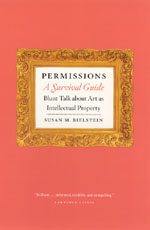The labyrinthine world of copyright law

Eugene G. Schwartz offers an excellent review of Susan Bielstein’s guide through the labyrinthine world of visual image copyright law, Permissions, A Survival Guide: Blunt Talk about Art as Intellectual Property, for his latest posting on ForeWord magazine’s Publishing Matters blog:
Before the internet, and especially before desk top publishing, you pretty much had to work with physical copies of things.… This imposed a variety of practical barriers that kept the leakage of rights to a minimum and concentrated its more substantial flow in the hands of professional thieves.
All of that has changed—and with the low cost and ubiquity of scanners, [and] cell phone cameras… gate-keeping the rights of images is like keeping a safe deposit box in a room with an open window.
Nonetheless, the publishing industry still relies on copyright law as the foundation of its economic viability. As all who read ForeWord well know, publishers have struggled to cope with establishing rights in an electronic world, and authors and agents have been pushing back while warily going with the flow.
All of this leads to a book I’d like to recommend to any of you who are interested in the subject, and especially if you deal with pictures as well as intellectual property and copyright in general: Permissions, A Survival Guide. Blunt Talk about Art as Intellectual Property, by Susan M. Bielstein.
The author is the executive editor for art, architecture, classical studies and film at the University of Chicago Press.… The practical value of this work is that it draws on the author’s experience and she takes you through the details of everything from choosing the size and format of digital files that you may be ordering to how to negotiate on price with museums. There is also a useful bibliography and a short list of image banks and artist’s rights organizations.
The real meat on the bone of this work, however, is the author’s blending of anecdotal experience, procedural advice and a critical effort to point the way out of the box that electronic reproduction and increasing layers of rights control are putting the users of creative assets—adding thickets of procedural obstacles and barriers of cost that lead either to shrinking use and availability or increasing use without permission.
Read the rest of the review on the Publishing Matters blog.
Also, read an excerpt from the book.